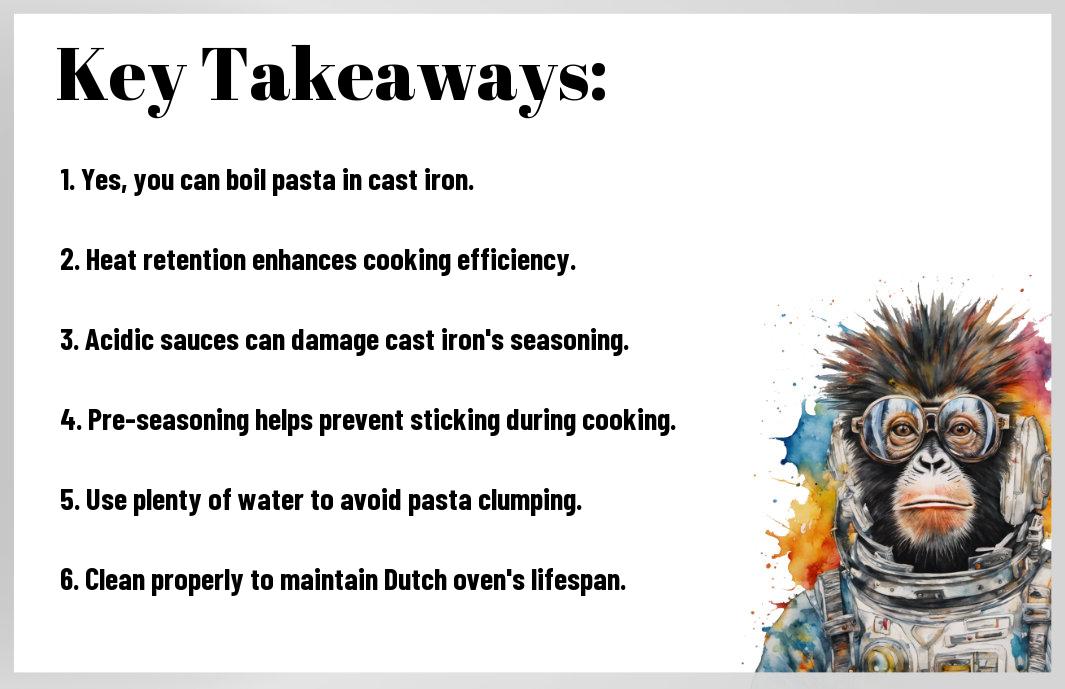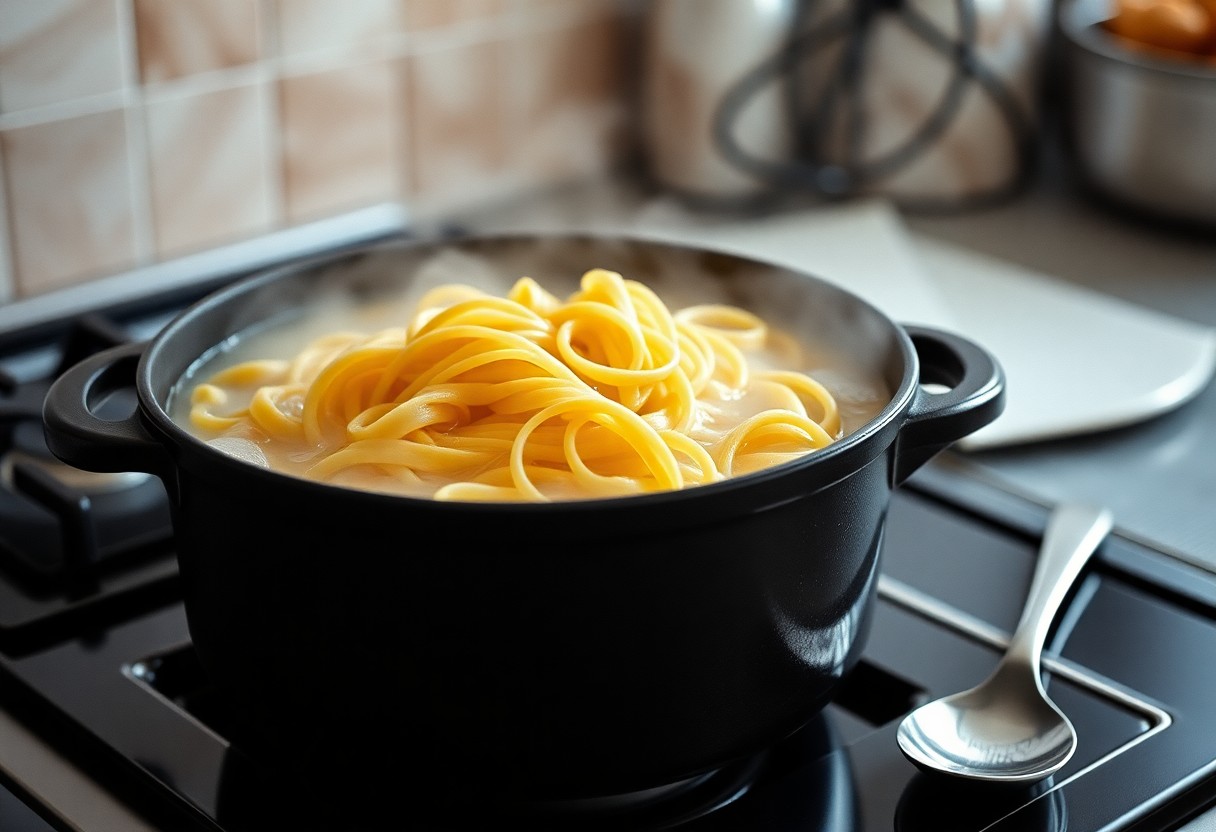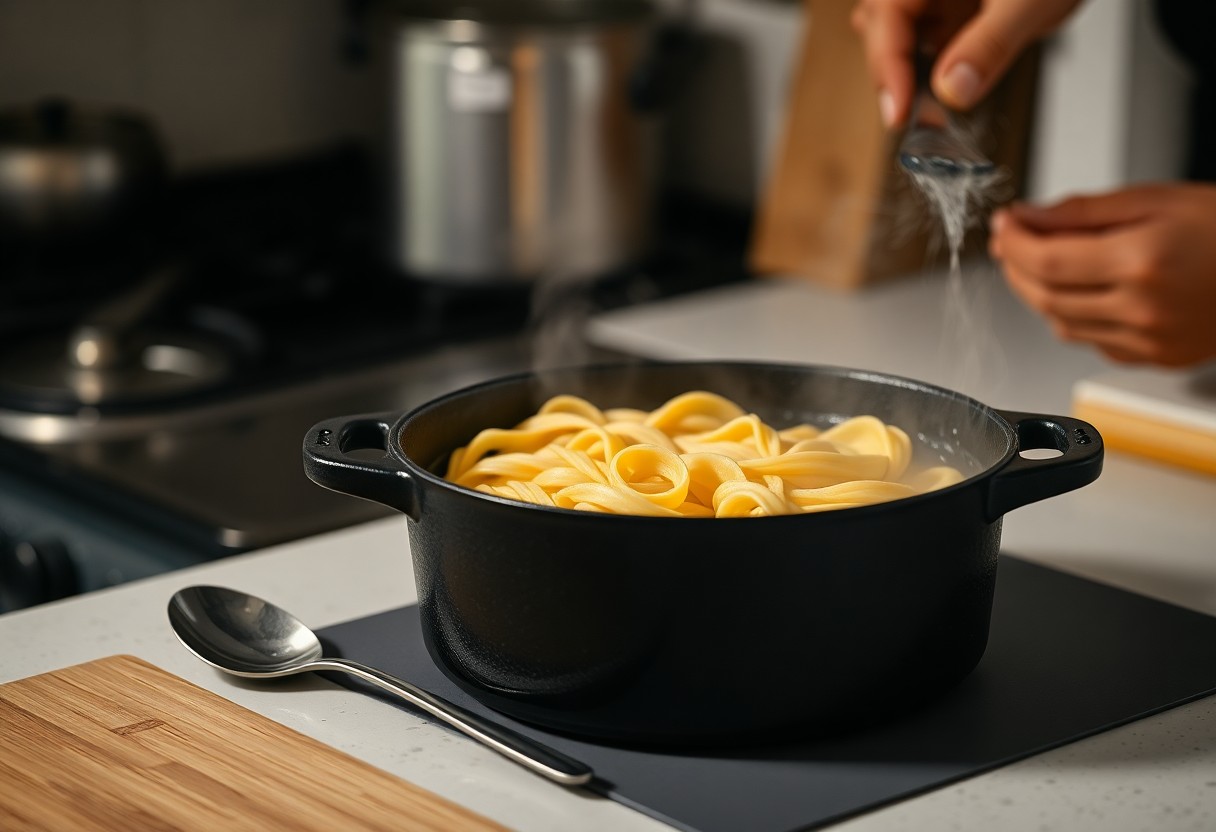It’s common to wonder if you can boil pasta in a cast iron Dutch oven. While these versatile pots are excellent for a variety of cooking methods, there are some important considerations to keep in mind. You’ll explore the advantages, such as fantastic heat retention, alongside potential drawbacks like the risk of food sticking. By following some best practices, you can ensure perfect pasta every time, making your cooking journey smoother and more enjoyable.
Key Takeaways:
- Boiling pasta in a cast iron Dutch oven is possible; however, be mindful of the seasoning, as high heat and acidic sauces can strip it away.
- The heat retention properties of cast iron can help maintain a steady boil, but it may take longer to reach a boil compared to traditional pots.
- To prevent food sticking, it’s advisable to use ample water and stir the pasta occasionally during cooking.

Benefits of Using a Cast Iron Dutch Oven for Boiling Pasta
To cook pasta in a cast iron Dutch oven offers numerous advantages, including excellent heat retention, even cooking, and a versatile cooking vessel. This sturdy cookware can be an invaluable addition to your kitchen, allowing you to prepare flavorful dishes. The combination of its durable construction and ability to maintain optimal temperatures makes it an exceptional choice for boiling pasta, ensuring you achieve that perfect al dente texture for your meals.
Heat Retention and Distribution
Any cook knows that even heat distribution is necessary for boiling pasta evenly. A cast iron Dutch oven excels in this area, providing consistent heat that prevents hot spots. This means your pasta will cook thoroughly, reducing the chances of unevenly soft or overcooked sections. The durability of cast iron also means it retains heat exceptionally well, keeping your pasta warm and ready to serve.
Versatility Beyond Pasta Cooking
Beside boiling pasta, a cast iron Dutch oven offers immense versatility for your cooking needs. You can use it for braising, roasting, baking, and even frying, making it a multifunctional kitchen companion. This adaptability allows you to explore various recipes, from soups and stews to casseroles and baked goods, all in one piece of cookware.
Retention of heat and moisture makes a cast iron Dutch oven perfect for a wide range of dishes. You can use it for slow-cooking meats, sautéing vegetables, or even baking bread. This means you can simplify your cooking process by using a single pot for multiple tasks, thus allowing for easier cleanup and less clutter in your kitchen. When you invest in a high-quality Dutch oven, you’re not only ensuring delicious pasta but also a comprehensive cooking solution for countless meals. The durability of cast iron guarantees it will be a lasting staple in your kitchen for years to come.
Potential Drawbacks of Boiling Pasta in Cast Iron
Some drawbacks accompany boiling pasta in a cast iron Dutch oven. First, the heavy material retains heat, which can lead to hot spots and uneven cooking. Additionally, there are concerns regarding sticking, especially if the pot is not well-seasoned. Lastly, the pot’s substantial weight may pose challenges during pouring and handling, particularly when full of boiling water and pasta.
Seasoning Concerns
Above all, using a cast iron Dutch oven for boiling pasta can affect its seasoning. Boiling water can strip away some of the seasoning layer if your pot is not adequately seasoned. This may increase the risk of food sticking and potentially lead to rusting if the seasoning is compromised.
Weight and Handling Difficulty
Concerns about weight and handling difficulty arise when using a cast iron Dutch oven for boiling pasta. The pot is naturally heavy, and when filled with water, it can become very cumbersome. Pouring out boiling water can be hazardous, as the weight can make the pot difficult to control, increasing the risk of spilling hot liquid and causing burns. Taking extra care during handling and utilizing proper lifting techniques can help mitigate these risks, ensuring a safer cooking experience.

Best Practices for Boiling Pasta in a Dutch Oven
Now that you know you can boil pasta in a Dutch oven, it’s imperative to follow some best practices to get perfect results. Ensure that you preheat the pot, use the right amount of water, and maintain an appropriate boiling temperature. By paying attention to these factors, you’ll make the process more efficient and enjoyable while getting delicious pasta every time.
Pre-Heating the Pot
Dutch ovens retain heat exceptionally well, so pre-heating your pot is a smart move. Place your Dutch oven on medium heat for a few minutes before adding water. This step helps to reach a rolling boil faster, ensuring your pasta cooks evenly and reduces the chance of sticking.
Using the Right Amount of Water
Right from the start, the amount of water you use for boiling pasta can make a significant difference. Aim for at least 4 to 6 quarts of water for every pound of pasta to encourage proper cooking and avoid clumping. Insufficient water can lead to sticky pasta and uneven cooking. Additionally, make sure that your pot is filled adequately to allow the pasta to move around freely while boiling.
This means that for a successful boiling experience, you should always use enough water to create a robust boil. If you skimp on water, you risk the dreaded gloppy texture and may even end up with undercooked pasta. By maintaining the right water-to-pasta ratio, you ensure that your pasta cooks evenly and absorbs just the right amount of flavor from your sauce, leading to a satisfying final dish.
Recommended Pasta Types for Cast Iron Cooking
Unlike traditional pots, cooking pasta in a cast iron Dutch oven requires selecting the right types of pasta for optimal results. Below are some recommended pasta types that fare well in your cast iron cookware:
| Type of Pasta | Cooking Time |
| Spaghetti | 8-10 minutes |
| Fettuccine | 10-12 minutes |
| Penne | 9-11 minutes |
| Rigatoni | 11-13 minutes |
| Macaroni | 7-9 minutes |
Knowing which pasta types work best will enhance your cooking experience and ensure delicious outcomes when using your cast iron Dutch oven.
Long Pasta Options
Cast iron Dutch ovens are well-suited for long pasta varieties like spaghetti and fettuccine. These pasta types benefit from the even heat distribution offered by cast iron, resulting in a consistent cook. You can enjoy delicious, al dente long pasta that perfectly holds your sauce, enhancing the overall dish.
Short Pasta Options
Recommended short pasta options include penne, rigatoni, and macaroni. These pasta types are ideal for cast iron cooking as they create compact bites full of flavor. You will find that the unique texture and shape of short pasta complements the robust heat retention and distribution of your Dutch oven.
To make the most of short pasta options, focus on pairing them with rich sauces or baked dishes. The absorbent nature of these pasta types helps them soak up flavors, while their sturdy structures withstand high temperatures. Ensure to monitor cooking times carefully, as overcooking can lead to mushy pasta. Using your cast iron Dutch oven, you can achieve aromatic, hearty meals that highlight the best of short pasta varieties.

Cleaning and Maintenance Tips for Post-Cooking
Many individuals overlook the importance of proper cleaning and maintenance of their cast iron Dutch oven after boiling pasta. To ensure your cookware remains in excellent condition, follow these tips:
- Let the pot cool down completely before cleaning.
- Use hot water and a soft sponge for scrubbing.
- Avoid using soap, as it can strip away seasoning.
- Dry the pot thoroughly to prevent moisture retention.
- Apply a light coat of oil to maintain the seasoning.
Assume that you invest time in maintaining the pot, and it will serve you well for years to come.
Avoiding Rust
To keep your cast iron Dutch oven rust-free, ensure it is fully dried after each wash. Moisture can cause rust formation, so avoid leaving it in the sink or damp areas. Store your pot in a dry place, and consider placing a paper towel inside to absorb any residual moisture. Regularly checking for any signs of rust will help you take action early and maintain the longevity of your cookware.
Restoring Seasoning
Besides regular maintenance, you may find the need to restore the seasoning on your cast iron Dutch oven from time to time. This process rejuvenates the non-stick layer and ensures it functions properly.
PostCooking the seasoning involves thoroughly cleaning your cast iron Dutch oven to remove food residues and old seasoning. Start by scrubbing with hot water and a stiff brush. After drying, apply a thin layer of vegetable oil or flaxseed oil to the cooking surface and heat the oven upside down in the oven at around 400°F for an hour. This step is imperative to create a new non-stick surface while preventing future rust buildup. Performing this technique regularly keeps your cast iron Dutch oven in top shape for boiling pasta and other cooking tasks.
Alternatives to Using a Cast Iron Dutch Oven for Pasta
Once again, if you’re considering alternatives to boiling pasta in a cast iron Dutch oven, there are several effective options to explore. Classic cookware such as stainless steel or enameled pots are often lighter and designed specifically for boiling, providing superior heat conduction. Additionally, if you prefer a specialized approach, you might want to look into specific pasta cookers, which can simplify the process and deliver optimal results.
Traditional Pots
For boiling pasta, traditional pots made of materials like stainless steel or aluminum are recommended. These pots offer excellent heat distribution and make it easy for you to control the boiling process. Their large sizes also accommodate substantial amounts of water, ensuring that your pasta cooks evenly and thoroughly.
Specialty Pasta Cookers
At a glance, specialty pasta cookers can take your pasta preparation to the next level. These devices are designed specifically for boiling pasta and often feature integrated strainers and other convenient tools. This means you can easily drain your pasta without the risk of spills or burns, making your cooking experience safer and more enjoyable.
The main advantage of specialty pasta cookers is their convenience. They come equipped with features like built-in strainers, which allow you to drain your pasta without additional equipment, reducing the chance of accidents. Additionally, specialty cookers often boast designs that promote even boiling and better heat retention, which can enhance the final texture of your pasta. If you find yourself frequently cooking pasta, investing in one of these cookers could greatly simplify your cooking routine.
Summing up
Upon reflecting, you can effectively boil pasta in a cast iron Dutch oven, taking advantage of its heat retention and even cooking. However, be cautious about potential sticking and the need for sufficient water to prevent burning. With the right techniques, such as proper seasoning and temperature management, your pasta can turn out delicious. Embrace the uniqueness of using this versatile cookware, and enhance your culinary skills for a satisfying meal experience.
FAQ
Q: Can I boil pasta in a cast iron Dutch oven?
A: Yes, you can boil pasta in a cast iron Dutch oven. It’s quite effective due to its ability to retain and distribute heat evenly. Just ensure that there’s enough water and that the pot is placed on a high enough heat to reach a rolling boil.
Q: What are the pros of boiling pasta in a cast iron Dutch oven?
A: Boiling pasta in a cast iron Dutch oven has several advantages. One major benefit is excellent heat retention, which helps maintain consistent cooking temperatures. Additionally, the large surface area allows for ample pasta cooking space, and the pot can double as a serving dish when finished.
Q: Are there any cons to using a Dutch oven for boiling pasta?
A: While there are benefits, there are also some drawbacks. Cast iron Dutch ovens tend to be heavy, making them less convenient to handle when filled with boiling water and pasta. Furthermore, if the pot is not well-seasoned, there’s a risk of pasta sticking to the bottom. Care must be taken to prevent scratching the seasoning if using metal utensils.
Q: What are the best practices for boiling pasta in a cast iron Dutch oven?
A: To boil pasta effectively, start by using enough water—typically about 4-6 quarts for a pound of pasta. Bring the water to a rolling boil before adding salt, then the pasta. Stir occasionally to prevent sticking. Make sure to monitor the cooking time closely, and if your Dutch oven is not enameled, avoid cooking acidic sauces in it to preserve the seasoning.
Q: How can I clean my Dutch oven after boiling pasta?
A: Cleaning a cast iron Dutch oven requires care. Allow it to cool slightly after cooking. For basic cleanup, use hot water and a soft sponge; avoid soap if the pot is not enameled. For stuck-on food, a gentle scrub with coarse salt can help. Always dry it thoroughly and apply a light layer of oil to maintain its seasoning.